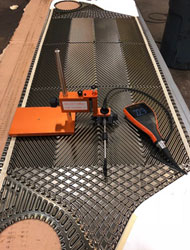Plate & Frame Exchanger Coating
The use of heat exchanger internal coating has been proven for plate and frame type designs. Ultra-low DFT anti-foul coatings improve release performance in tight tolerance channels where heat exchanger fouling impacts operations.
Fouling in plate heat exchangers Scaling and fouling in Plate and Frame Heat Exchangers (PFE) results in significant loss of performance and negatively affects energy efficiency of the system.
In severe cases, the buildup could be so thick that it results in a clogged exchanger – unable to be cleaned in place (CIP) with acidic cleaning techniques. This leads to production stoppages for cleaning and ultimately results in increased production costs.
Recent studies from industry have introduced compelling evidence that altering the surface of the plate with a thin layer of antifouling coating mitigates the effects of fouling in heat exchangers and reduces maintenance stoppages. The same studies indicated a thin thermally-conductive-antifouling-coating-layer allows for far more heat transfer than a layer of scaling and fouling material of the same thickness.

Curran uses hybrid Sol Gels that are functional in applications at 5-20 microns film thickness. Applied at a thin layer, the coating demonstrates its release using a Dyne Pen 30 test of surface tension, which proves surface energy of the coating at 30 dynes/cm2 or less. Essentially this means high release, non-wettable surface.
Quality control also includes thickness verification; dry film thickness measurements are taken using a meter thickness gauge mounted on a probe placement jig to ensure accuracy.
Curran International successfully coats PFE heat exchangers for clients in the oil and gas industry. The scope includes applying a thin layer of antifouling-conductive-coating to both sides of each plate, while ensuring that gasket areas are protected and left uncoated.
To ensure the coating material was applied to the proper thickness, each plate goes through a quality control process. Dry film thickness measurements are taken using an Elcometer® with an angled probe placed in a Probe Placement Jig to verify that specified thicknesses of the Curran Coating were achieved.
The goal is to utilize a thin film coating specifically formulated for antifouling – applied as thin as the specification would allow. This would ensure the coating adhesion and curing mechanisms will not be affected while ensuring the most thermal-conductivity was achieved.
SEO Services by Essential Information Technologies
Copyright © Curran International All rights reserved.
